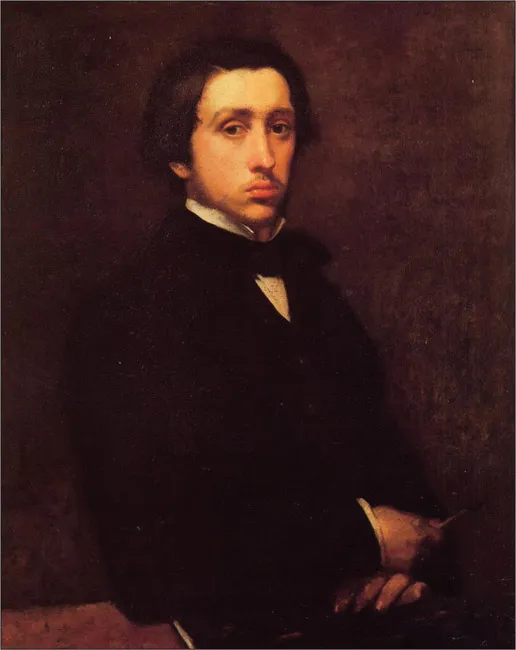![]()
EDGAR DEGAS
1839–1917
Edgar Degas began as a classical painter of genre history scenes and died as one of the greatest and most innovative names in French art—although as with so many other artists, he did not receive a great deal of recognition in his lifetime. Along the way his style changed completely from strict academic formalism to near-abstract scenes of contemporary Parisian life. His primary subject was the human form, especially that of women, and he also loved the vibrancy of horse racing.
Degas is usually labeled an Impressionist because he was friendly with many of the Impressionist painters and was a founder of the Impressionist movement, but he actually rejected the characterization and referred to his style as “realism.” He considered one of the Impressionists’ basic tenets—painting en plein air—ludicrous and only painted in a studio, using models for his figures or simply relying on his memory of a scene. Nevertheless, he did exhibit in seven of the eight Impressionist exhibitions.
Above all, Degas was a superb draftsman. This skill, coupled with his innovative eye, allowed him to generate an entirely new compositional approach to painting, making him one of the truly great recorders of ordinary lives. Once he found a subject, he would work at the composition repeatedly, calculating the angles and tones, and returning many times to the subject until he was satisfied with the result. In later life, he also became interested in photography, which helps explain why angles and viewpoints in his paintings became so innovative. The fresh view of the lens opened his artistic eye to intriguing new possibilities of perspective and apparently spontaneous composition.
Degas said, “I know nothing of inspiration, spontaneity, temper; what I do is the result of a long reflection and a study of the great masters.” His greatest artistic idol was Ingres, but he also admired the Italian Renaissance painters, as well as Velasquez, Goya, Poussin, and David. Although a classicist at heart and by training, Degas wanted to explore the possibilities of art and take it into new realms. This goal and vision he shared with the Impressionists: a desire to “see” in new ways. But he never wanted or intended to abandon what had gone before. He famously said, “Ah, Giotto! Let me see Paris! And you, Paris—let me see Giotto!”
All his life Degas was temperamental, restless, and easily provoked into bad temper. His impatient nature may explain the tremendous and intense output that he produced and also why so many of his works remained unfinished. In his early years, he had a comfortable private income and thus did not have to ingratiate himself to anyone.
Between 1873 and 1883, he concentrated on women working in the ballet and in cafés, women bathing nude, and dancers in the music halls as well as onlookers thronging the race track. Degas first went to the Paris Opera to see the ballet when he was over 40 years old, and for the next 30 years made the dancers his principal subjects and grand obsession. He is particularly remembered for his paintings of young ballet dancers. He rarely showed the public performance of the dance and instead depicted rehearsals, dance classes, costume fittings, the long waits between dancing, and the dance masters; in other words, he portrayed the boredom and the stress rather than the magic and the dazzle. That was what really intrigued to him. He wanted to show the strain behind the perfection. He became obsessed with the subject and in later years focused on ballet dancers again and again. When he was asked by an American collector, “Why Monsieur, do you always do ballet dancers?” he shot back, “Because, Madame, it is all that is left us of the combined movements of the Greeks.” In essence, the classical discipline of the dance had to be celebrated above all.
It wasn’t the ballet itself that enthralled him, although he did love the art form, but rather dance was his way to “distract and console” himself from his own life. He was interested in the secrets that dancing bodies conveyed and the things dance portrayed about the human condition. He came to know the ballet wel...

